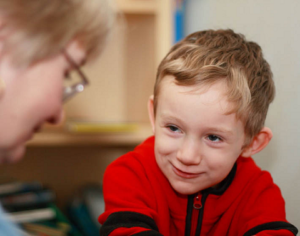Autism Spectrum Classroom Strategies: 12 Effective Tips

|
Getting your Trinity Audio player ready...
|
Classroom Strategies for Students on the Autism Spectrum: Supporting Youth in School
As a behavior specialist and school psychologist, I am often asked about classroom strategies for Autism Spectrum Disorder and how schools can support students on the spectrum.
Obtaining an Individualized Education Program (IEP)
Children on the autism spectrum often have an Individualized Education Program (IEP) in school to enable them to have specific goals, accommodations, and modifications.
However, some parents may be unsure how to obtain an IEP, and once they do obtain it, they may be unclear about what should go in the IEP or how schools provide the support listed in the IEP.
For more information, see:
- How Do You Know if Your Child Needs an IEP at School
- 15 Behavior Strategies for Children on the Autism Spectrum
Sometimes students without an IEP can also obtain support in school. It is important to ask your school what they can provide for your child’s needs.
Strategies for Supporting Students on the Autism Spectrum in School
It is essential to provide effective strategies to students on (and off) the autism spectrum throughout the school day, both in and out of the classroom. These strategies are helpful for all kids, not just those on the spectrum.
1. Practice Social Skills and Self-Regulation
Some children on the autism spectrum may struggle to cope with their emotions in stressful situations or navigate social interactions.
Board games like Mad Dragon: An Anger Control Card Game and CBT: 123 present scenarios for children to practice, talk about, and think about how to handle challenging situations.
Role-playing these scenarios in real-life situations with support can be beneficial.
For more activities to practice social skills, check out:
- 5 Great Activities to Do with Your Social Skills Group
- 8 Fun Activities to Practice Social Skills at Home
2. Read Social Stories
Social stories can help children with autism prepare for and understand expectations in various social situations, such as coming to school, going to the doctor, or visiting a restaurant. Creating social stories using Microsoft Word and Google Images or using personal pictures can make these stories more relatable.
Examples of social stories include:
3. Pair the Student with a Buddy
Some children on the autism spectrum have trouble finding a friend in school. This can be a source of anxiety. There are often other children in the same situation.
Try to pair a child with another child that they could possibly make a connection with.

Maybe they can create a project together, do a puzzle together, take a walk in the hall, or play basketball in the gym. Maybe an older student can be a helper to a younger student. If there is not a peer in the child’s class or grade to pair them with, try to think outside of the box. I am sure there is someone they can pair up with.
You May Like: Help a Child Who is Alone at Recess
4. Allow Time for Exercise
Research shows that exercise is great for reducing anxiety and improving self-esteem. We are also aware that children on the autism spectrum often exhibit a strong need for movement.
You May Like: Exercise Video for Kids
Exercise can help a child on the spectrum reduce their anxiety, channel their energy productively, improve their self-esteem, and take part in a social activity. Exercise is also a great way to practice self-control.
Children on the autism spectrum often thrive on routine, and exercise can be built into any routine.
Related Article: How to Use Exercise to Support Kids with Autism and ADHD
5. Use a Schedule
As mentioned earlier, children on the autism spectrum often respond to predictability and routine. Having a familiar schedule that allows them to anticipate what comes next can alleviate anxiety and foster smoother transitions.

Example: A Specific Morning Routine
If the class schedule simply states “complete morning routine,” a child on the autism spectrum may benefit from a more detailed schedule, like the one below:
- Take off backpack
- Hang up coat
- Sit at desk
- Take out notebook and pencil
By customizing schedules to fit each child’s unique preferences and comfort levels, we can enhance their sense of ease and confidence throughout the day.
For more on this topic, see How to Use Schedules to Improve Children’s Behavior.
6. Providing Movement Breaks for Optimal Learning
As stated before, children on the autism spectrum often have a lot of energy and a need to move. Your child can be given breaks throughout the day to engage in movement and positively channel the energy.
Movement breaks also give your child something to look forward to. For instance, if they know that they will have a break after completing a reading activity, it can reduce anxiety about having to sit for a prolonged period.
If a child has a need to move, it is only right to provide him/her with opportunities for movement. Withholding this will only make the child focus more on when they will be able to get their energy out, and it will be harder for them to sit when needed.
Movement breaks can include taking a walk, getting up and stretching, running errands in the school, passing out materials, doing chores in the school building, swinging on a swing, etc.
7. Embrace Hands-On and Visually-Based Activities
Research shows that children on the autism spectrum do best with visually structured tasks. 19 years of experience in this field has also shown me that children with autism often thrive with hands-on and movement-based activities.
For instance, I taught a six-year-old child on the spectrum to learn letter sounds by taping letters to the wall and having him run and touch the right letter when I called out the letter sound. We also taped letters on the floor and had to jump on the letters in the right order to spell a word.
This child was not interested in sitting and learning about letter sounds, but once it was turned into a fun, structured game with movement, his engagement and participation greatly increased, and he learned letter sounds and how to read basic words.
8. Provide Choices for Learning Activities When Possible
All children like to feel a sense of control over their world and want to do what they love. Allowing your child to make choices about how he learns and what he learns naturally leads to increased participation, engagement, and learning.
For instance, when I asked a child if he wanted to learn about ordinal places (1st, 2nd, 3rd) by drawing a picture or by lining up his transformers, he picked the transformers. He was engaged in the activity and with practice, understood the concept. I structured it in a visual way (we drew circles on paper in a line and put one transformer on each circle).
We did first, second, third, and fourth positions. The student had to identify who was in each position and name the position when it was pointed to. He was also asked to switch the transformers around (e.g., put the yellow in the first position and the red one in the second position). He needed guidance at first but eventually identified all places independently.
This is just an example. Think about how choices can be incorporated into a child’s learning at school.
9. Provide Choices of Preferred Activities
Again, children want to feel some control over their environment. Many children benefit from breaks to engage in a preferred activity (e.g., computer time, play a game with a friend, draw a picture, read a book of choice). When a child knows that he has the opportunity to work towards preferred activities, they are often more willing to participate in a non-preferred learning activity (e.g., first we will review your math flashcards, then you can have ten minutes of computer time to do an activity of choice).
I have personally seen motivation and cooperation improve in a child on the autism spectrum when they know what they are working towards and when they will be able to take a break. Breaking up tasks into manageable steps with breaks in between leads to much greater engagement and learning than trying to get a child to keep going when they need a mental or physical break.
10. Structure Activities to Help the Child Know How Long the Activity Will Last
Children on the autism spectrum often do best when they know how long an activity or break will last, so structure them in a clear way. This will lead to increased participation and easier transitions between activities.
For instance, if you are reviewing flashcards, have ten cards that the child can see. This way, they know when you get through the ten cards, the activity will be finished. If you are doing a more open-ended activity, like reading, you can use a timer so the child knows how long the video will last. You can use a visual timer for children who have trouble understanding the countdown of a traditional timer.
There are several ways that you can clearly delineate the ending of an activity. Think about how to make the ending clear to the student.
Where Can You Get a Visual Timer?
You can search for a free visual timer in the app store on your mobile phone or tablet. You can also order a real visual timer online, such as the one below.
11. Incorporate Interests and Strengths into Learning
We all do best when activities tap into our personal interests and strengths. For instance, if someone is just learning to read and does well with puzzles, use that to your advantage. Get puzzles that incorporate a reading component.
If someone else loves to draw and make posters, let them demonstrate what they learned in class by creating a poster. If someone is great at singing and making up songs, allow them to write a song to demonstrate a concept they learned.
Think outside of the box to find ways to incorporate a child’s strengths and interests into learning.
12. Use Clear Concrete Instructions to Communicate Expectations
It is important to tell a child what you expect (e.g., take out your book and put it on your desk) rather than what you don’t expect (e.g., stop fooling around). Some children need directions stated one step at a time, only stating the next direction after they have completed the first. (“Take out your book.” “Put your book on your desk.”).
Some students benefit from a list of each direction/step and/or visual images to understand the directions. Work together to develop a plan that works within the school setting and benefits the child.
There are many things we can do to provide effective strategies to students on (and off) the autism spectrum throughout the school day (both in and out of the classroom).
It is important that we stay up to date on current research-based practices through sites like Education and Behavior or Understood.org.
What strategies did you use in your school or classroom today to help a child?
Related Article: Printable Classroom Rules with Matching Visuals
Research References:
- Practical Teaching Strategies for Students with Autism Spectrum Disorder – A Review of Literature
- Evidence Based Practice Brief Autism Spectrum Disorder
[embeddoc url=”https://educationandbehavior.com/how-to-help-students-with-autism/practical-teaching-strategies-for-students-with-autism-spectrum-disorder-a-review-of-literature-2/”]
[embeddoc url=”https://educationandbehavior.com/how-to-help-students-with-autism/evidence-based-practice-brief-autism-spectrum-disorder/”]
One thought on “Autism Spectrum Classroom Strategies: 12 Effective Tips”
Comments are closed.








Thank you, Anne!